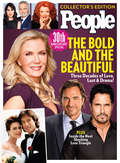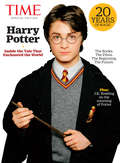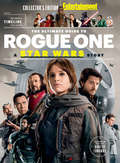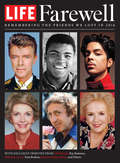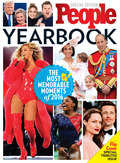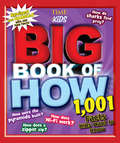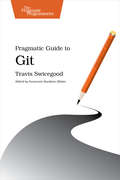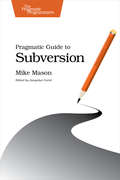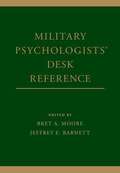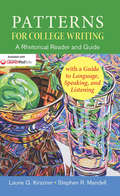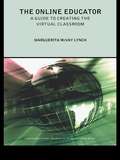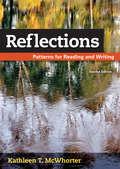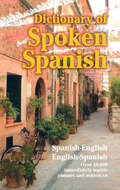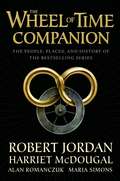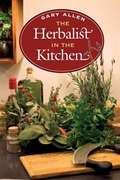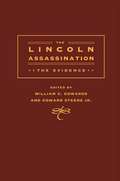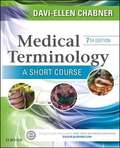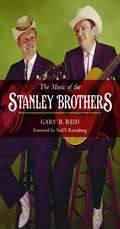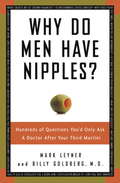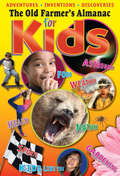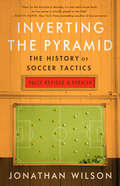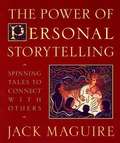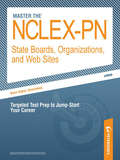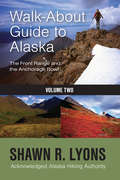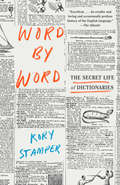- Table View
- List View
PEOPLE Bold & the Beautiful: Three Decades of Love, Lust & Drama!
by The Editors of PEOPLEIn this new, photo-packed collector's edition, People takes you inside the world's most-watched soap opera for its 30th anniversary. Featuring new interviews with the current cast and the show's producers, whose family was the model for the glamorous Forresters. Go on the set and get a behind-the-scenes look at 30 years of feuds and fashion, right up to the latest surprising love triangle. Plus: All of Brooke's marriages (and splits); the most shocking twists; weddings; runway shows; memorable guest stars (Betty White!); and the hottest Bold men.
TIME Harry Potter: Inside the Tale That Enchanted the World
by The Editors of TIMEThe exploits of Harry Potter brought a new kind of magic to children's literature. Author JK Rowling's uncanny ability to nourish the human hunger for enchantment led people young and na?ve, old and jaded, to surrender to the illusions set forth in Harry Potter's fictional world.
The Ultimate Guide to Rogue One: A Star Wars Story (Entertainment Weekly Collector's Edition)
by Gareth Edwards The Editors of Entertainment WeeklyThirty-nine years after the first Star Wars movie entranced audiences around the world comes Rogue One, the franchiseÍs first spinoff film. And now, to celebrate the arrival of a new chapter, Entertainment WeeklyÍs editors and writers bring you a collectorÍs edition that takes you deep inside the universe of Rogue One. The 96-page guide is packed with revealing new interviews with the cast; rarely seen photos of production, new characters, and creatures; and a timeline of the entire Star Wars saga. Extras for fans include:Foreword by director Gareth EdwardsMap of the Star Wars galaxyDeep dives on the Death Star, Darth Vader, and Stormtroopers
LIFE Farewell: Remembering the Friends we Lost in 2016
by The Editors of LifeCelebrating the people we lost in 2016, LIFE's commemorative collector's edition gives an intimate look back at the lives of David Bowie, Prince, Harper Lee, Patty Duke, and many more. Featuring exclusive personal tributes from Tom Brokaw on Nancy Reagan, Susan Lucci on the creator of All My Children, Travis Tritt on Glenn Frey, Billy Ray Cyrus on Merle Haggard, Leslie Stahl on Morley Safer, Ray Romano on Doris Roberts, Mel Brooks on Gene Wilder, and Kareem Abdul-Jabbar on Muhammed Ali.
PEOPLE Yearbook: The Most Memorable Moments of 2016 & Those We Lost in 2016
by The Editors of PEOPLEPeople highlights the memorable and significant moments of 2016 and profiles those we lost this year.
Big Book of How Revised and Updated (A TIME for Kids Book)
by The Editors of Time For KidsHow does a chameleon change colors? How do astronauts train for a space mission? How do diamonds form? How does Wi-Fi work?The best-selling book in TIME For Kids' Big Book of Questions series is newly revised with updated information, photos, illustrations, and graphics to answer over 500 new questions in popular subject areas: Animals, Space, History, Science, Technology, Sports and more. Presented in an easy-to-follow format, this fun, must-have reference book will appeal to a young child's sense of curiosity. Kids can dive into the book at any point and learn over 1,001 amazing facts to impress their parents, teachers, and friends with their new found knowledge.
Pragmatic Guide to Git
by Travis SwicegoodNeed to learn how to wrap your head around Git, but don't need a lot of hand holding? Grab this book if you're new to Git, not to the world of programming. Git tasks displayed on two-page spreads provide all the context you need, without the extra fluff.
Pragmatic Guide to Subversion
by Mike MasonSubversion is the most popular open-source version control system on the planet. Development teams-big and small, enterprise and open source-use this fast, feature-rich tool daily. Pragmatic Guide to Subversion presents the 48 essential tasks you need to know. It's your shortcut to the Subversion master's recommended set of best practices. With this book, you can get to the good parts quickly, and be more productive and effective.
Military Psychologists' Desk Reference
by Bret A. Moore Jeffrey E. BarnettMilitary Psychologists' Desk Reference is the authoritative guide in the field of military mental health, covering in a clear and concise manner the depth and breadth of this expanding area at a pivotal and relevant time.
Patterns for College Writing: A Rhetorical Reader and Guide
by Laurie G. Kirszner Stephen R. MandellPatterns for College Writing is a best-seller in high schools because its approach to writing works- focusing students on the kinds of reading and writing they will need to do in order to succeed in class and on their state and national exams. The authors provide students with exemplary models and instructors with class-tested selections that balance classic and contemporary essays. <P>Along with more examples of student writing than any other reader, Patterns has the most comprehensive coverage of active reading, research, and the writing process, with a five-chapter mini-rhetoric; the clearest explanations of the patterns of development; and the most thorough apparatus of any rhetorical reader. The new edition includes exciting new readings and expanded coverage of critical reading, working with sources, and research.
The Online Educator: A Guide to Creating the Virtual Classroom
by Maggie McVay LynchThe internet is changing the way we live and education has always played an important part in shaping our lives. It is now time for education to capitalise on the Internet's capabilities to create a new learning environment for tomorrow's students.The Online Educator provides much needed straightforward advice on how to create a web-based education system. From Administrative planning and selecting resources to individual course development, it offers clear, novice-friendly information on the entire process of online learning. Key features include:*clear definitions of common terms and concepts*a practical 'how-to' approach with useful checklists*a discussion of the issues for students and teaching staff*links to useful websites and other resources.Based firmly on current distance learning research, yet accessible and very readable, this book will be indispensible to anyone interested in developing online education.
Reflections (Second Edition): Patterns for Reading and Writing
by Kathleen T. McwhorterThis innovative modes-based reader by reading expert Kathleen McWhorter supports an integrated approach to reading and writing with unique scaffolded instruction that guides students through comprehension, analysis, evaluation, and written response -- skills students will need to be successful in college. Compelling reading selections drawn from widely taught academic disciplines let students practice the work they're expected to do in other college courses. The second edition has been thoroughly revised with a new grammar handbook, expanded research coverage, new readings, and new features to provide stronger, more integrated reading and writing advice. Reflections can be packaged with LaunchPad Solo for Readers and Writers, allowing you to more efficiently track students' progress with reading, writing, and grammar skills in an active learning arc that complements the book.
Dictionary of Spoken Spanish
by U. S. War DeptThis is a complete, unabridged republication of a Dictionary of Spoken Spanish, which was specially prepared by nationally known linguists for the U.S. War Department (TM#30-900).It is compiled from spoken Spanish and emphasizes idiom and colloquial usage in both Castilian and Latin American areas. More than 16,000 entries provide exact translations of both English and Spanish sentences and phrases; as many as 60 idioms are listed under each entry. This is easily the largest list of idiomatic constructions ever published.Travelers, business people, and students who are interested in Latin American studies have found this dictionary their best source for those expressions of daily life and social activity not usually found in books. More than 18,000 idioms are given, not as isolated words that you have to conjugate or alter, but as complete sentences that you can use without change.A 25-page introduction provides a rapid survey of Spanish sounds, grammar, and syntax, with full consideration of irregular verbs. It is especially apt in its modern treatment of phrase and clause structure. A 17-page appendix gives translations of geographical names, numbers, national holidays for Spanish countries, important street signs, useful expressions of high frequency, and a unique 7-page glossary of Spanish and Spanish-American foods and dishes.
The Wheel of Time Companion: The People, Places, and History of the Bestselling Series (The Wheel of Time)
by Robert Jordan Alan Romanczuk Maria Simons Harriet McDougal<P>Since its debut in 1990, The Wheel of Time® by Robert Jordan has captivated millions of readers around the globe with its scope, originality, and compelling characters. Over the course of fifteen books and millions of words, the world that Jordan created grew in depth and complexity. However, only a fraction of what Jordan imagined ended up on the page, the rest going into his personal files. <P>Now The Wheel of Time Companion sheds light on some of the most intriguing aspects of the world, including biographies and motivations of many characters that never made it into the books, but helped bring Jordan's world to life.
The Herbalist in the Kitchen (The Food Series)
by Gary AllenThe foodie's ultimate herbal encyclopedia Created as the ideal reference for anyone with a serious interest in cooking with herbs, spices, or related plant materials, The Herbalist in the Kitchen is truly encyclopedic in scope. It provides complete information about the uses, botany, toxicity, and flavor chemistry of herbs, as well as a listing for nearly every name that an ingredient is known by around the world. Even including herbs and spices not yet seen in the United States (but likely to be featured in recipes for adventurous cooks soon), The Herbalist in the Kitchen is organized into one hundred and four sections, each consisting of a single botanical family. The book provides all available information about the chemical compounds responsible for a plant's characteristic taste and scent, which allows cooks to consider new subtleties and potential alternatives. For instance, the primary flavoring ingredient of cloves is eugenol; when a cook knows that bay leaves also contain eugenol, a range of exciting substitutions becomes clear. The Herbalist in the Kitchen also provides guidance about measuring herbs, enabling readers to understand the dated measuring standards from antique cookbooks. A volume in The Food Series, edited by Andrew W. Smith
The Lincoln Assassination: The Evidence
by Edward Steers William C. EdwardsOn April 22, 1865, Brevet Colonel H. L. Burnett was assigned to head the investigation into the murder of President Abraham Lincoln and the attempted murder of Secretary of State William H. Seward. Burnett orchestrated the collection of thousands of documents for the Military Commission's trial of the conspirators. This deep archive of documentary evidence--consisting of letters, depositions, eyewitness accounts, investigative reports, and other documents--provides invaluable insight into the historical, cultural, and judicial context of the investigation. Only a fraction of the information presented in these documents ever made its way into the trial, and most of it has never been readily accessible. By presenting an annotated and indexed transcription of these documents, this volume offers significant new access to information on the events surrounding the assassination and a vast new store of social and political history of the Civil War era. "With tears in my eyes I think it your duty to hang every rebel caught. I feel as bad as if was my own mother or father & will be one to volunteer to try & shoot every Southern man. May God have mercy on the man's soul that done such a deed. With much Respect for our Country, I remain Weeping" --Anonymous letter, New York, April 15, 1865 "I know Booth. He was in the habit of coming to my place to shoot. . . . He shot well, and practiced to shoot with accuracy in every possible position. . . . He was a quick shot; always silent, reticent." --Deposition of Benjamin Barker, Pistol Gallery proprietor
Medical Terminology: A Short Course (7th Edition)
by Davi-Ellen ChabnerQuickly master the basics of medical terminology and begin speaking and writing terms almost immediately! Using Davi-Ellen Chabner's proven learning method, Medical Terminology: A Short Course, 7th Edition omits time-consuming, nonessential information and helps you build a working medical vocabulary of the most frequently encountered prefixes, suffixes, and word roots. Medical terms are introduced in the context of human anatomy and physiology to help you understand exactly what they mean, and case studies, vignettes, and activities demonstrate how they're used in practice. With all this plus medical animations, word games, and flash cards on the Evolve companion website, you'll be amazed at how easily medical terminology becomes part of your vocabulary.
The Music of the Stanley Brothers (Music in American Life)
by Neil V. Rosenberg Gary B. ReidThe Music of the Stanley Brothers brings together forty years of passionate research by scholar and record label owner Gary Reid. A leading authority on Carter and Ralph Stanley, Reid augments his own vast knowledge of their music with interviews, documents ranging from books to folios sold by the brothers at shows, and the words of Ralph Stanley, former band members, guest musicians, session producers, songwriters, and bluegrass experts. The result is a reference that illuminates the Stanleys' art and history. It is all here: dates and locations; the roster of players on well-known and obscure sessions alike; master/matrix and catalog/release numbers, with reissue information; a full discography sorting out the Stanleys' complex recording history; the stories behind the music; and exquisitely informed biographical notes that place events in the context of the brothers' careers and lives. Monumental and indispensable, The Music of the Stanley Brothers provides fans and scholars alike with a guide for immersion in the long career and breathtaking repertoire of two legendary American musicians.
Why Do Men Have Nipples?: Hundreds Of Questions You'd Only Ask A Doctor After Your Third Martini
by Billy Goldberg Mark LeynerIs There a Doctor in the House?Say you're at a party. You've had a martini or three, and you mingle through the crowd, wondering how long you need to stay before going out for pizza. Suddenly you're introduced to someone new, Dr. Nice Tomeetya. You forget the pizza. Now is the perfect time to bring up all those strange questions you'd like to ask during an office visit with your own doctor but haven't had the guts (or more likely the time) to do so. You're filled with liquid courage . . . now is your chance! If you've ever wanted to ask a doctor . . .*How do people in wheelchairs have sex?*Why do I get a killer headache when I suck down my milkshake too fast?*Can I lose my contact lens inside my head forever?*Why does asparagus make my pee smell?*Why do old people grow hair on their ears?*Is the old adage "beer before liquor, never sicker, liquor before beer . . ." really true? . . . then Why Do Men Have Nipples? is the book for you.Compiled by Billy Goldberg, an emergency medicine physician, and Mark Leyner, bestselling author and well-known satirist, Why Do Men Have Nipples? offers real factual and really funny answers to some of the big questions about the oddities of our bodies.From the Trade Paperback edition.
The Old Farmer's Almanac for Kids
by Old Farmer’s AlmanacFascinating stories, fun facts, and activities that provide hours of edu-tainment make a winning formula for this biannual series created for kids ages 8 and up. This brand-new edition includes chapters with features on . . . <br> * Astronomy: Earth's volcanoes and other planetary wonders <br> * Calendar: origin of the birthday cake, why we save daylight time, and more "special" days <br>* Health: fun facts about your brain; uncommon advice for the common cold; why we have burps, gas, and other unmentionables <br> * Weather: wildfire weather, facts about fog <br>* Food: the history of the hot dog, the making of maple syrup, the first frozen dinner, lunchbox recipes <br> * Accomplished Kids: kids who made amazing discoveries, kids who help to make the world a better place <br> * Nature: a bug guide, little-known facts about nuts, poison dart frogs <br> * In the Garden: secrets of composting, growing a bean teepee and other edibles, plus fun crafts <br> * Sports: a wooden car derby, plus adventurers Sam Patch (falls jumper), Jay Cochrane (wire walker), and Charles F. Lummis (cross-country hiker)* Amusement: tips for setting a record, advice for whistlers, and more <br>* Plus too much more to mention!
Inverting The Pyramid: The History of Soccer Tactics
by Jonathan Wilson<P>Inverting the Pyramid is a pioneering soccer book that chronicles the evolution of soccer tactics and the lives of the itinerant coaching geniuses who have spread their distinctive styles across the globe. <P>Through Jonathan Wilson's brilliant historical detective work we learn how the South Americans shrugged off the British colonial order to add their own finesse to the game; how the Europeans harnessed individual technique and built it into a team structure; how the game once featured five forwards up front, while now a lone striker is not uncommon.Inverting the Pyramid provides a definitive understanding of the tactical genius of modern-day Barcelona, for the first time showing how their style of play developed from Dutch "Total Football," which itself was an evolution of the Scottish passing game invented by Queens Park in the 1870s and taken on by Tottenham Hotspur in the 1930s. <P>Inverting the Pyramid has been called the "Big Daddy" (Zonal Marking) of soccer tactics books; it is essential for any coach, fan, player, or fantasy manager of the beautiful game
Power Of Personal Storytelling: Spinning Tales to Connect with Others
by Jack MaguireYou're stuck in an endless, dull conversation. As the speaker drones on, your mind wanders, until you hear the words, "I remember once when I was.." Your ears perk up. You become engrossed. An anecdote unfolds, and suddenly, the speaker is alive and excited and you know just what he means. He has used the age-old technique of storytelling to powerfully get his point across, capturing your attention through a well-told narrative of personal experience that invited you to relate to his message on an intimate level. In The Power of Personal Storytelling, professional storyteller Jack Maguire explains how to mine your memories to communicate more effectively, enhance personal and professional relationships, and understand yourself better so that you can better understand others. Step by step, he illustrates how shaping and expressing true stories about our lives and those of the people we've known can: * connect us more vitally with others; * develop our creativity; * strengthen our humor, courage, and confidence; and * render our lives more memorable. Whether you're a teacher or a salesman, a minister or a parent, personal storytelling can help improve the key relationships in your life while investing your memories with more meaning.
Master the NCLEX-PN: State Boards, Organizations and Web Sites
by Ray GolaszewskiA complete listing of state boards of nursing as well as contact information for PN/VN professional organizations, along with pertinent Web resources for health, education, and job information.
Walk About Guide To Alaska: The Front Range and the Anchorage Bowl
by Shawn LyonsShawn Lyons, an avid hiker and hill scrambler, grew up in the Boston area, and spent his early years wandering the White Mountains. At the age of 17, he hiked the Appalachian Trail from Georgia to Maine and at 18 hiked the Long Trail from Massachusetts to Canada. Since moving to Alaska, he has continued to hike and climb extensively. So much that after countless long hikes through innumerable valleys and over many summits, Shawn is the Acknowledged Alaska Hiking Authority. As an ultra-athlete, he is a nine-time winner of the Iditashoe wilderness snowshoe race, and three-time winner of the 100-mile Coldfoot Classic held each year on Halloween above the Arctic Circle. Shawn's narratives about his hikes and races often appear in hiking and climbing publications.
Word by Word: The Secret Life of Dictionaries
by Kory StamperDo you have strong feelings about the word “irregardless”? Have you ever tried to define the word “is”? Brimming with intelligence and personality, this vastly entertaining account of how dictionaries are made is a must-read for word mavens. Many of us take dictionaries for granted, and few may realize that the process of writing dictionaries is, in fact, as lively and dynamic as language itself. With sharp wit and irreverence, Kory Stamper cracks open the complex, obsessive world of lexicography, from the agonizing decisions about what to define and how to do it, to the knotty questions of usage in an ever-changing language. She explains why small words are the most difficult to define, how it can take nine months to define a single word, and how our biases about language and pronunciation can have tremendous social influence. And along the way, she reveals little-known surprises—for example, the fact that “OMG” was first used in a letter to Winston Churchill in 1917. Word by Word brings to life the hallowed halls (and highly idiosyncratic cubicles) of Merriam-Webster, a startlingly rich world inhabited by quirky and erudite individuals who quietly shape the way we communicate. Certain to be a delight for all lovers of words, Stamper’s debut will make you laugh as much as it makes you appreciate the wonderful complexities and eccentricities of the English language.
